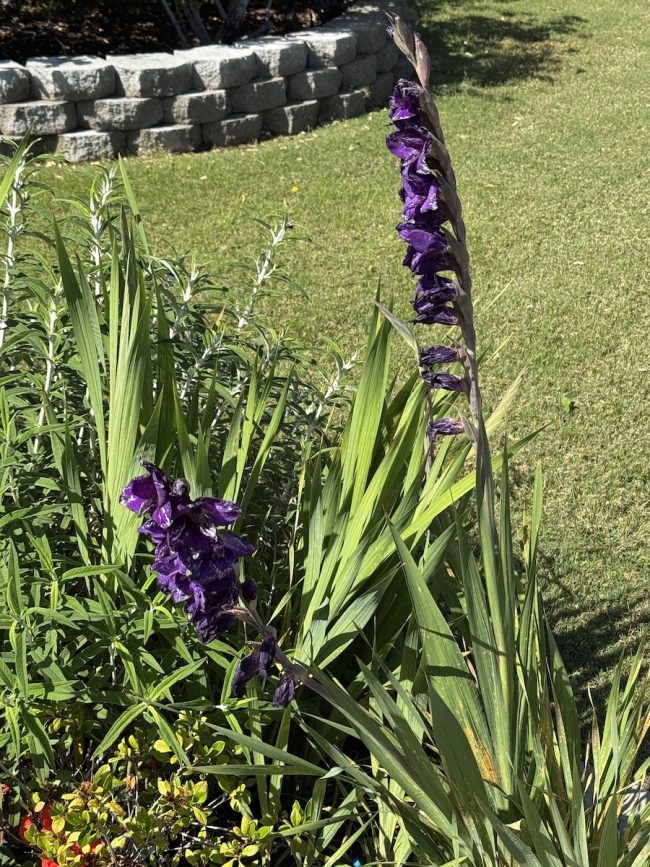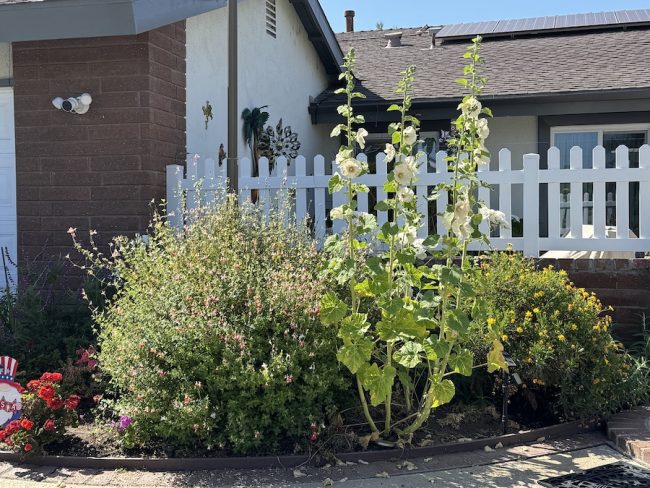Estimated reading time: 3 minutes

No big plans today except for Girls Night Out. We did take our morning walk, and I made it 0.7 miles only sitting down once; a new record. We snapped a couple of shots of our front yard.

We are decorated for the next holiday as soon as I change out the flag.
The front yard flowers are doing quite well and are making the front of the house look great! The gladiolus not only has roots in the ground but also in ancient history. Named for their shape and appearance, the term gladiolus stems from the diminutive form of gladius, which means “sword” in Latin. Translated literally, a gladiolus is “a little sword.” Gladioli have also been called xiphium, which comes from the Greek word, xiphios, which also means sword. In addition to the name gladiolus, the flowers have been referred to as sword or corn lilies.

Our gladiolas get new homes every time we depart; Mary likes to give flowers to our friends.
The second set of Hollyhocks had emerged to the left of the front gate. They are seven feet tall already and show no signs of slowing down.

The blossoms will be stuffed this week.
After the walk, we prepared to depart for the Elks Lodge for our weekly Girls Night Out.
We stopped on the way so I could do another blood test. This time I fooled them, I studied for several hours before the test and I passed it with flying colors. One Sponge Bob Square Pants band-aid later, I was out the door and on our way to the lodge!
We were pleased to see Ed Roberts and Betty at the lodge this fine day. The regulars were also there, so nine of us celebrated and drank wildly (isn’t water and Diet Coke wild??).
After lunch, we stopped by the cleaners and deposited several dress shirts that needed some TLC.
Muhammad Ali and Joe Frazier go to a Dry Cleaner. The owner says, “Can I help you?”
They say, “How much to wash an old pair of boxers?”
In the afternoon MAry took a short nap and I attacked the flower bed digging up a celery plant. The pant always looks good but the taste is not! So, I looked up why and got the following answers:
Here’s a more detailed explanation of why celery might taste bitter:
1. Insufficient Nutrients: Celery requires a rich, nutrient-rich soil to thrive. If the soil lacks essential nutrients, the celery plants might become stressed, leading to a bitter taste.
2. Excessive Heat: Celery prefers cooler temperatures and can become bitter if exposed to prolonged heat stress.
3. Water Deficiency: Celery needs consistent moisture. If it’s not adequately watered, the stalks can become stringy and bitter.
4. Over-maturity: Overly mature celery plants can have a bitter taste.
5. Lack of Blanching: Blanching, the process of covering the stalks with soil or paper to prevent sunlight exposure, can help reduce bitterness. Blanching encourages the celery to develop a sweeter, milder flavor.
6. Improper Storage: Celery can also become bitter if stored incorrectly or for too long.
7. Growing Conditions: Celery thrives in soil with a pH between 5.8 and 6.8 and requires well-drained, moisture-retentive soil.
8. Plant Age and Maturity: Harvesting celery when it’s young and tender can also help prevent bitterness.
